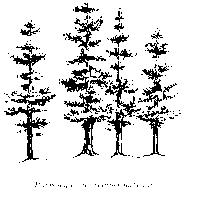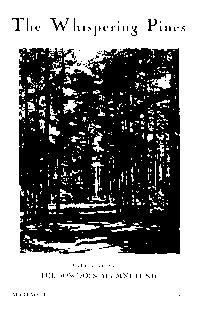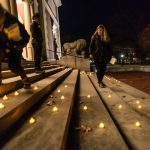In his latest column, John Cross ’76 explains why “we always have the whispering pines.”
Bowdoin’s pines have been associated with the College since its beginnings-not as early as the Bowdoin sun seal (a version of which was adopted in 1799), but pre-dating the use of the Bowdoin family coat of arms (1811), and more than a century before the selection of the polar bear as the College’s official mascot in 1913. At the time of Bowdoin’s founding white pines covered much of the sandy plain that extended eastward from the college grounds.
O ye familiar scenes, – ye groves of pine,
That once were mine and are no longer mine”¦”
“Morituri Salutamus,” 1875
-Henry Wadsworth Longfellow
In 1805, a year before the graduation of Bowdoin’s first class, a group of students formed the Philomathian literary society (“lover of learning”). The group soon sought a unique identity, since Philomathian societies existed at other colleges and universities, and in 1807 adopted the name “Peucinian,” derived from the Latin for pitch pine, because “”¦.Cambridge in England has its willows, Oxford its osiers and we have our pines”¦Every literary society can be a Philomathian society and the name has been often applied but every society cannot be a Peucinian Society nor has there been one.” For its motto, “Pinos loquentes semper habemus” (“We always have the whispering pines”) the society adapted a passage from Virgil’s Eclogues VIII; the translation here is from MIT’s Internet Classics Archive:
| Maenalus argutumque nemus | Ever hath Maenalus his murmuring groves |
| pinosque loquentes semper habet; | and whispering pines, |
| semper pastorum ille audit amores Panaque, qui primus calamos non passus inertes. | and ever hears the songs of love-lorn shepherds, and of Pan, who first brooked not the tuneful reed should idle lie. |
Another literary society, the Athenæans, was formed at the College in 1808, and after a few faltering attempts became established as a challenge to the Peucinians. The story of the political leanings of each society, their rivalries, their famous members, the private libraries that they accumulated, and their eventual disappearance in the 1880s is worthy of a scholarly article or book. In 2007 Bowdoin students re-established a Peucinian Society to carry on a tradition of discussion and debate. Meetings are held in The Peucinian Room in the lower level of Sills Hall; the paneling and mantelpiece in the room were milled from pine trees removed during the construction of Sills Drive in 1948.
In September of 1933 the Alumni Fund published The Whispering Pines, a 30-page bulletin that listed donors to the College, summarized Commencement activities, printed the address of President Sills at the opening of the College, and carried an order form for grandstand ($2.00) or bleacher tickets ($1.10) for football games. The old Peucinian motto was printed on the title page of the bulletin, which was produced by the Alumni Office into the mid-1950s. In 1962 Secretary of the Alumni Fund Robert Cross ’45 circulated a newsletter as “a letter from home” to keep fund volunteers informed about events, announcements, and life on campus. By popular vote, the volunteers chose “The Whispering Pines” as the name for the newsletter, and pine trees and “Pinos loquentes semper habemus” soon appeared on the masthead. The circulation list was expanded to included members of the Governing Boards, and later to all alumni. Bob wrote The Whispering Pines from 1962 to 1990, Harry Warren continued the tradition from 1990 to 1997, and I took over from 1997 to 2008. In 2008 the newsletter was discontinued and replaced by an essay in the back of Bowdoin magazine. In March of 2010 I also began writing this monthly column for the Bowdoin Daily Sun.
Despite more than two centuries of association with pinos loquentes, Bowdoin can’t claim exclusive rights to the phrase; over the years alumni have brought to my attention the broad range of business enterprises that also hear the whispering of pines. Nothing in what follows should be construed either as an endorsement or a criticism of any particular business, product, or service. Not surprisingly, the phrase “whispering pines” appears in the yellow pages most frequently linked to a business in the hospitality or outdoor recreation industries. There are dozens of campgrounds, resorts, cottages, cabins, hunting lodges, day camps, motels, and bed-and-breakfast establishments that go by the “whispering pines” name. Golf courses are another popular category, as are mobile home parks, apartment complexes, and assisted living facilities. I should not have been surprised, then, to discover the Whispering Pines Nudist Resort and Campgrounds in North Carolina, nor the existence of a Polar Bares naturist group in Maine. Under a Whispering Pines sign in nearly any state of the union one might find an elementary school, a winery, a funeral home, a dental clinic, a pet cemetery, a church, a ranch or farm, or a breeder of dogs, rabbits, horses, alpacas, or miniature Nubian goats. A Whispering Pines counseling service in Iowa advertises that “healing is through the whispering.” In the music world, “Whispering Pines” might refer to the title of a much-covered song by The Band, a track by country singer Johnny Horton, or “a five-piece cosmic California boogie band” of the same name.
Closer to home, in the early 1870s the Reverend Elijah Kellogg of the Class of 1840 wrote six books in “The Whispering Pine” series for young men about college life. A large pine named in his memory still stands between Kanbar Hall and Druckenmiller Hall and is the oldest pine tree on the campus. I’m not sure of the Kellogg Pine’s age, but it is probably in excess of the usual life expectancy for white pines of 125 years or so. The towering pines that line the Bath road east of the campus were planted in about 1910 by Austin Cary of the Class of 1887, a pioneer in the field of forestry in America. Over time large trees have succumbed to disease, to lightning, to wind, and to ice and snow, but each time the canopy opens to the sun’s light, new growth renews the vigor of the grove. I like to think that whispered messages of continuity and renewal are carried on the slightest breeze in Bowdoin’s pines.
With Best Wishes,

John R. Cross ’76
Secretary of Development and College Relations



